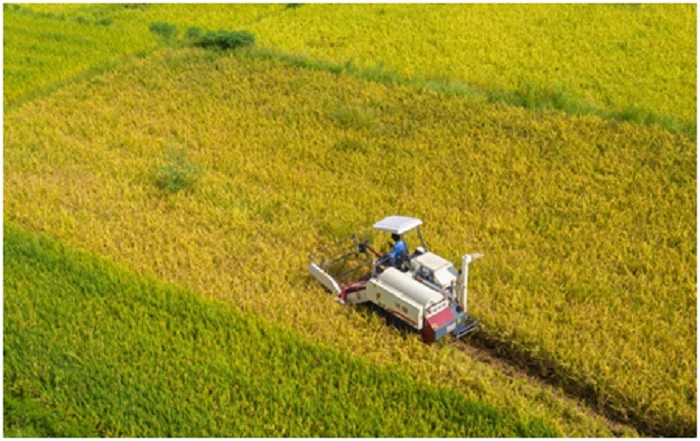



In the face of risks and challenges brought about by the COVID-19 epidemic, plant diseases and insect pests since the beginning of the year, China has made every effort to facilitate agricultural production and ensure stable production and supply of grain and non-staple food.
After overcoming the adverse effects of regional drought, warm winter, late spring coldness, as well as wheat diseases and insect pests during the first half of the year, China reaped another bumper summer grain harvest.
China’s summer grain output reached a record high of 142.8 billion kg this year, 1.21 billion kg more than that of the previous year.
This year’s summer grain harvest has witnessed a higher quality of grain, with the proportion of first and second-grade wheat increasing and the planting area of strong gluten and weak gluten wheat accounting for 35.8 percent of the nation’s total wheat planting area, which represents a year-on-year increase of 2.8 percentage points.
So far, China has basically finished early rice harvest and seen a clear upward trend in output.
China has stepped up efforts to promote an increase in the yield of early rice to ensure food security this year.
Early rice production has exhibited three features, according to Pan Wenbo, head of crop production department at the Ministry of Agriculture and Rural Affairs.
Firstly, the planting area of early rice increased by about 313,333 hectares, reversing the downward trend in the past seven years, Pan noted.
The floods in south China did not change the general trend of output increase, he added.
Besides, the planting area of high-quality early rice accounted for 46.2 percent of the nation’s total, 2 percentage points higher than that in the previous year, according to Pan.
Pan also pointed out that the sown area of autumn grain has increased steadily, and the crops in the fields are growing well, laying a good foundation for a bumper grain harvest throughout the year.
Non-staple food and grain supply have always been a main concern of people, especially in this year when floods have aroused great attention to agricultural production and food security in the society.
Overall, China has guaranteed adequate supplies of grain and non-staple foods with stable prices.
From January to June, the average monthly price of rice, wheat and corn in the market fairs stood at 242.48 yuan (about $35.06) per 100 kg, which was at the same level as that of the previous year, according to the Ministry of Agriculture and Rural Affairs (MARA).
At the same time, the total output of winter and spring vegetables was 170 million tons, a year-on-year increase of 2 percent, suggested data from the MARA, which indicated that the average minimum purchase price for 30 major types of vegetables had fallen by 8.4 percent year on year during the first half of the year.
The price of fruits also had also dropped after a rise during the first six months of the year, when the average price of six types of fruits at wholesale markets fell by 13.4 percent from that of the same period last year.
Recently, floods have caused certain impacts on agricultural production in some areas, but the impacts are limited and temporary, Pan said.
Various areas in China have strengthened the deployment of agricultural machinery to ensure that the early rice harvest could be completely smoothly and the late rice be planted in a timely manner, according to Pan.
At the same time, they have promptly drained water in the fields and grown crops with relatively short growth periods to promote the recovery of production after the disaster and reduce losses, Pan disclosed.
As of August 5, China’s government wheat purchases in major production areas stood at over 42.8 million tons this summer, down about 9.38 million tons year on year, according to data released by the National Food and Strategic Reserves Administration on August 12.
Market survey suggests that many farmers are reluctant to sell wheat this year, while they used to be very active in selling grain after the crops had just been reaped in previous years.
Market-oriented purchase has made framers more sensitive to the market, which means they now prefer selling grain in a more balanced way throughout the year to selling all the products in a specific period of time of the year, noted Shang Jinsuo, head of a grain storage facility in Baixiang county, North China’s Hebei Province.
The selling period has thus become longer as many farmers choose to store the grain and then sell it according to market demands to maximize their income, Shang added.
Experts believe that farmers have stronger awareness of risks against the backdrop of normalized epidemic prevention and control.
The amount of grain stored by farmers in the main production areas has increased compared with the previous years, according to a survey conducted by the National Food and Strategic Reserves Administration.
China is totally self-sufficient in rice and wheat supply and the self-sufficiency rate of major grain exceeded 95 percent, said Li Guoxiang, researcher at the Rural Development Institute, Chinese Academy of Social Sciences, adding that wheat supply is not only ensured, but has a surplus every year.
Annual grain output in the country has remained stable at more than 650 billion kg for five consecutive years, and the national grain reserves are relatively sufficient, Li pointed out.


The Humanitarian Service Diamond Awards has.
A Chinese Company, Inner Galaxy Steel.


The Programme Coordinator, Regulatory, Compliance and.


A Non-Governmental Organization (NGO), Committee for.
The Trustfund Pensions Limited has chided.


The House of Representatives Committee on.
The China General Chamber of Commerce.


Senator Chuka Utazi who represented Enugu.


An Abuja based Legal Practitioner, Ugochukwu.


The African business community in Yiwu,.
Leave a Comment